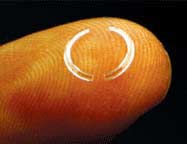Eyeglasses are certainly safe, relatively inexpensive and most people can tolerate them well. Sometimes, depending on the nature of the correction, the lenses may be thick and compromising to the size of the visual image. Complications associated with the use of glasses are rare, unless they become misplaced or restrict certain activities.
Contact lenses are a popular non-surgical alternative. Contact lenses come in a variety of materials and colors. Comfort, effectiveness, and ease of use vary with each individual. Since contact lenses rest directly on the cornea, not everyone is able to tolerate them well, and they may restrict certain activities. Well-fitted and used properly, contact lenses are effective and relatively safe. Complications arising from the use of contact lenses include allergic reactions, infections, scratches, ulcers, or other injuries to the cornea.
Clear lens extraction is a procedure in which the eye’s natural internal lens is removed and replaced with an intraocular lens implant, sometimes referred to as an “IOL”. In the past five years, it has become an acceptable alternative to other refractive procedures. Read more…
The Phakic intraocular lens is placed inside the eye without removing the natural lens, and performs much like an internal contact lens. There are some very exciting and promising phakic IOLs that are currently under study for FDA validation. Read more…
A type of Clear Lens Extraction, Prelex is a surgical procedure that attempts to correct presbyopia. It is a technology that has not gained complete acceptance by the medical community nor proven satisfactory with a number of patients. Seibel Vision Surgery does not offer Prelex. However, some new implants that are currently under investigation may make this a viable procedure, and Dr. Seibel will advise his patients when these new options will be available.
 Intacs are surgically implanted plastic half rings that change the shape of the cornea. A significant number of these devices were removed for complications during the FDA Phase III clinical trials. Seibel Vision Surgery does not offer Intacs.
Intacs are surgically implanted plastic half rings that change the shape of the cornea. A significant number of these devices were removed for complications during the FDA Phase III clinical trials. Seibel Vision Surgery does not offer Intacs.
PRK eye surgery is used in a number of cases instead of LASIK. It is primarily for those with dry eyes or for those whose cornea may be too thin to allow for the creation of the corneal flap required for LASIK eye surgery. During PRK eye surgery a small area on the corneal epithelium (surface cells) is gently polished away. The laser then reshapes the corneal surface in exactly the same way as for LASIK surgery. Read more…
In LASEK, the epithelium, or outer layer of the cornea, is cut with a fine blade called a trephine, which involves displacing the corneal epithelium as a sheet and then replacing it to act as a natural bandage. However, the epithelium is often not healthy afterwards and must regenerate over a very extended time period; a contact lens is usually required. Seibel Vision Surgery does not offer LASEK.
LTK used a holmium ‘heat’ beam laser instead of the ‘cool’ beam excimer laser to treat farsighted patients and is very limited in its application; the effects are not long lasting. Seibel Vision Surgery does not offer LTK.
RK was the first refractive procedure practiced in the U.S. on a wide scale. It was first introduced in the U.S. in 1978. Radial Keratotomy is seldom performed today because the excimer laser can achieve the same effect without placing deep radial incisions of RK, which effectively lead to a weakening of the structure of the cornea and frequently unstable results. Seibel Vision Surgery does not offer RK.
AK treats astigmatism by flattening the cornea with arc-shaped incisions in its periphery. It is similar in principal to RK with the same disadvantages. Seibel Vision Surgery does not offer AK.
Automated Lamellar Keratoplasty is a procedure that existed before LASIK eye surgery, and is now outdated. Seibel Vision Surgery does not offer ALK.
CK is a procedure in which a radio frequency probe rather than a laser is used to reshape the cornea. It is approved for low to moderate hyperopia in patients over age 40, however it does not appear to have the precision of LASIK and, in its initial studies, it actually caused new astigmatism in some patients. Seibel Vision Surgery does not offer CK.
At Seibel Vision Surgery, your eyes and vision are of paramount importance. To help you make the most informed decisions regarding the welfare of your vision, we are delighted to be of service and are happy to answer any questions you may have.
Please take the time to familiarize yourself with the information contained on this site. We have compiled it especially for you!
Monday, Tuesday, Wednesday, and Thursday
8:30 a.m. to 3:30 p.m.
Friday
8:30 a.m. to 3:00 p.m.
OUR ADDRESS
11620 Wilshire Boulevard, Suite 711
Los Angeles, California 90025
PHONE
(310) 444-1134
FAX
(310) 444-1130
Learn about cataracts and their treatment
Learn more about CataractsGlaucoma, Macular Degeneration,
Medical Eye Exams, and other